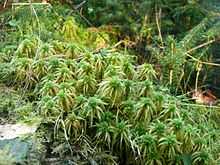Fascicle (botany)
In botany, a fascicle (in some cases called a short shoot when that is morphologically appropriate) is a bundle of leaves or flowers, or of the vascular tissues that supply these organs with nutrients.[1] Vascular tissues may occur in fascicles even when the organs they supply are not fascicled. In zoology and animal anatomy the term fascicle refers to a small bundle, usually of fibres, nerves, or vessels.[2]
Etymology of fascicle and related terms
The term fascicle and its derived terms such as fasciculation are from the Latin fasciculus, the diminutive of fascis, a bundle.[3] Accordingly such words occur in many forms and contexts wherever they are convenient for descriptive purposes. A fascicle may indeed be leaves or flowers on a "short shoot" where the nodes of a shoot are crowded without clear internodes, such as in species of Pinus or Rhigozum. However, bundled fibres, nerves or bristles as in tissues or the glochid fascicles of Opuntia may have little or nothing to do with branch morphology.
In pines


Leaf fascicles are present in all pines, and the number of adult leaves (needles) per fascicle is an important character for identification of pine species and genera. Most species have fascicles of 2 to 5 needles; only occasional species typically have as few as one or as many as six leaves to the fascicle.
Variation is high between species, low within them. For example, Pinus flexilis (limber pine), has fascicles of 5 needles. This pine is a member of the white pine group, Pinus subgenus Strobus, section Strobus. In all members of the group the fascicles have five needles and the sheath at the base of the fascicle is deciduous.
The fascicle sheath is another character that is important for identification. Among North American pines the sheath is persistent in all so-called hard pines and deciduous in all so-called soft pines.[4] Thus, the fascicle sheath and number of needles can be used to identify valuable timber pines in all seasons and many years before they are mature enough to produce cones. These two characters readily distinguish the major groups of pines (see Pinus classification).
Pinus durangensis (Durango pine) has fascicles of 6 needles, rarely 7, and is the only species in Pinus with so many needles per fascicle. Pinus monophylla has fascicles of one needle, rarely two. This is the only species of pine with just one needle per fascicle, and this rare and easily observed character is reflected in the specific epithet monophylla and common vernacular name single-leaf pinyon.
In flowering plants






Fascicles do occur in some flowering plants, though not as frequently as in many conifers. Consequently, when fascicles are present the specific epithet often refers to them.
Examples include Prunus fasciculata and Adenostoma fasciculatum. Species with flowers in fascicles include Aechmea biflora and Melicytus ramiflorus, several species of Malva, and the entire genus Flueggea. Some species of the family Alseuosmiaceae have flowers in fascicles.
In the Bignoniaceae in the genus Rhigozum flowers are borne in fascicles from cushion-like, dwarf branchlets in the axils of leaves, and several species also bear leaves in fascicles on similar or shared branchlets.[5]
Both leaf and flower fascicles occur among Angiospermae, often as adaptations facilitating pollination, such as in many Lamiaceae, of which some Lavandula are typical. Other plant fascicles are adaptations to achieve greater compactness for defensive reasons. For example, in Opuntia cacti, spines are produced in fascicles bearing a few long spines and many short spiny bristles (or glochids).
In lower plants
Sphagnum species bear branches in fascicles.
See also
- Spur
- Fascicle (disambiguation)
References
- ↑ Shashtri, Varun. Dictionary of Botany. Publisher: Isha Books 2005. ISBN 978-8182052253
- ↑ Sarup's Dictionary of Anatomy and Physiology. Publisher: Sarup & Sons, 2000. ISBN 978-8176250825
- ↑ Brown, Lesley (1993). The New shorter Oxford English dictionary on historical principles. Oxford [Eng.]: Clarendon. ISBN 0-19-861271-0.
- ↑ Fralish, James Steven; Franklin, Scott B. (2002). Taxonomy and ecology of woody plants in North American forests (excluding Mexico and subtropical Florida). John Wiley and Sons. p. 553. ISBN 0-471-16158-6.
- ↑ Dyer, R. Allen, “The Genera of Southern African Flowering Plants”. ISBN 0-621-02854-1, 1975